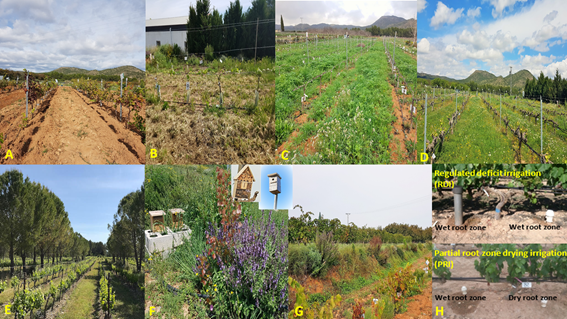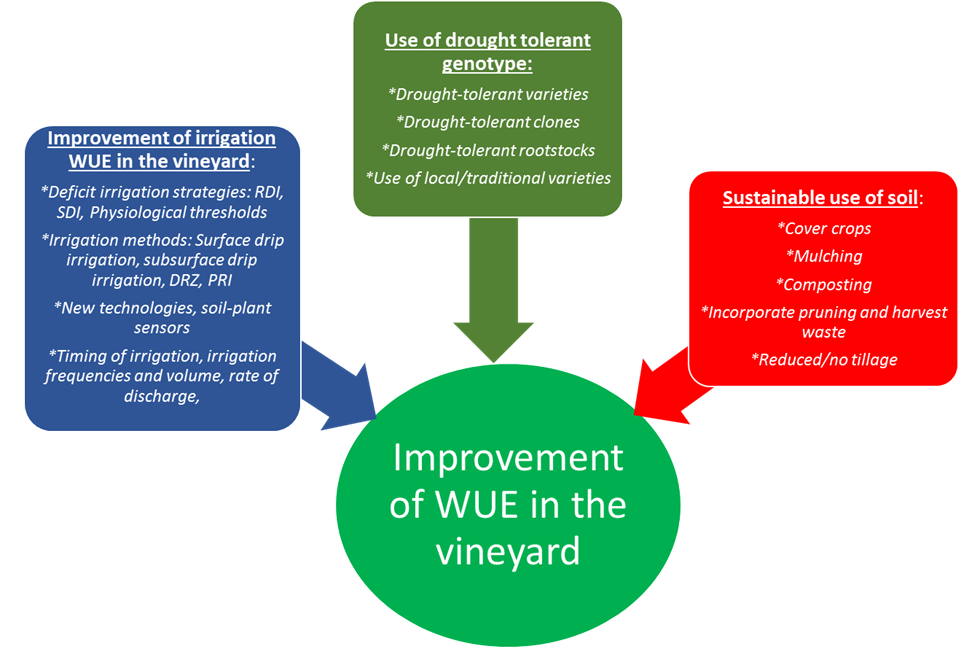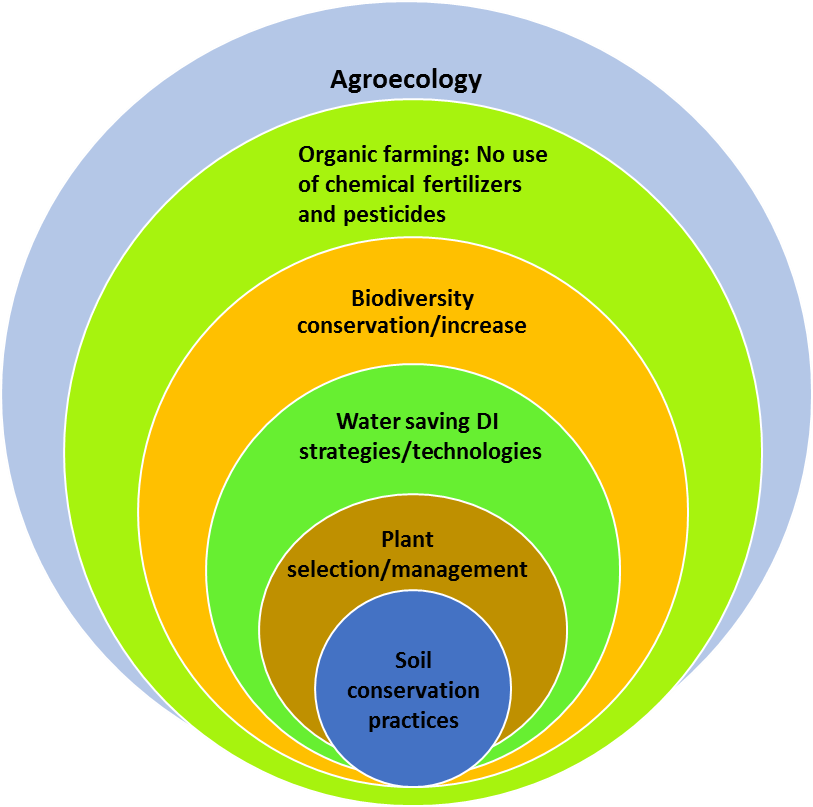by Pascual Romero, Josefa Navarro-Acosta and Pablo Botía
Fortunately, the interest in more sustainable and holistic approaches in viticulture (including organic, biodynamic, and agroforestry farming systems) is growing. Alternative farming systems place special emphasis on the health of the whole agroecosystem, with a strong focus on the preservation of biodiversity, soil fertility, and soil biological activity, by supporting the soil microorganisms and using good agroecological farming practices.
In recent years, a considerable effort has been made in Mediterranean vineyards to develop and optimize efficient irrigation techniques and deficit irrigation (DI) strategies (e.g. Regulated Deficit Irrigated, RDI) that require moderate/low water volumes, in order to improve berry quality and water use efficiency (WUE) quality in vineyards in semiarid areas, with successful results. However, we have less experience of efficient soil management in deficit-irrigated vineyards and we know little about the best sustainable soil management practices for improving long-term soil fertility and quality under deficit irrigated semiarid conditions.
More sustainable management of the soil, in addition to the ecosystem services generated, can have a direct effect on the soil water balance (evaporation, infiltration rate, water-holding capacity, etc.) and can increase the efficiency of the use of water and nutrients. This would allow us to save water, manage irrigation more efficiently, and possibly achieve better adaptation of DI vineyards to CC. The aim of this update-review is:
a) show the state of the art and the latest progress in the management of DI in vineyards.
b) identify and establish common criteria when developing and optimizing DI strategies.
c) translate novel physiological approaches and advances into the practical application of DI management, according to the genotypic characteristics and degree of drought tolerance of the variety/rootstock combination.
d) highlight the importance of how sustainable soil management and other agroecological practices can optimize the management and sustainability of DI in vineyards.
We hypothesize that the application of optimized water-saving DI strategies involving low-water volumes (such as RDI and PRI) – combined with drought-tolerant rootstock-scion combinations and sustainable soil management practices (such as composting, mulching, cover crops, and reduced tillage) – can decrease irrigation needs, optimize irrigation, and improve WUE in vineyards in semi-arid regions (Figures 1 and 2). Thus, it has a great potential role in the adaptation to and mitigation of CC. However, the greatest and most-durable benefits will likely result from the combination of these adaptation measures with more-radical agroecological measures that will increase biodiversity and strengthen the resilience of farms and rural communities. These include the diversification of agroecosystems in the form of polycultures, agroforestry systems, and crop-livestock mixed systems, the use of hedgerows and water conservation and harvesting, and the general enhancement of agrobiodiversity, heterogeneity, and complexity (Altieri et al., 2015). Landscape simplification increases vineyard pest outbreaks and insecticide use, while increasing landscape complexity reduces the likelihood of suffering pest outbreaks, thus decreasing the costs associated with yield losses and insecticide applications (Paredes et al., 2021). It has been also reported that increasing plant species diversity in agroecosystems at different spatiotemporal scales (e.g. floral/herbaceous cover crops, semi-natural field borders, trees), provides winter refuge for beneficial predators and parasitoids and reduces the impacts of crop pests and diseases as well as the dependence on synthetic plant protection products (Ratnadass et al., 2021).

The progression towards sustainability requires changes and improvements in the management of vineyards. With each step of improvement, the inputs are gradually reduced, while the water use efficiency (rainfall + irrigation), resilience, and sustainability in the vineyard increase. Many of these agronomic and agroecological practices can be combined in Mediterranean vineyards under more holistic approaches such as organic and biodynamic farming, but more research is necessary (Figure 3). The main objectives of these agroecological approaches are: a) to maintain/improve the fertility of the soil, b) to produce healthy plants that can resist diseases and pests, c) to increase agrobiodiversity, and d) to produce food of the highest possible quality. Agroecological practices that reduce the dependence of cropping systems on synthetic inputs are numerous and diverse and the transition towards agroecological systems can be progressive or fast (Merot et al., 2019). The transition towards organic farming is a good example of an advanced agroecological transition. The organic farming transition can be addressed in terms of sequences of input reduction (for higher efficiency, using precision viticulture), implementation of soil conservation practices, and input substitution (from mineral to organic fertilizers and approved pesticides) to achieve a redesigned organic farming system based on agroecological principles (Merot et al., 2019).

Vineyards are amongst the most intensive forms of agriculture, with a high use of pesticides (mainly herbicides and fungicides), and often result in simplified landscapes, increased soil erosion and soil and water pollution. Hence, organic viticulture can bring multiple benefits, especially related to the omission of pesticides and synthetic fertilizers and their associated negative effects (Gunstone et al., 2021) and the fostering of biological pest control services (Muneret et al., 2019) and increased biodiversity. Organic vineyards are considered environmentally sound when best practices are followed and show several agronomic, environmental, and economic benefits at different levels compared to conventional/integrated ones, but important challenges have to be addressed, specially related to high fungicide inputs (frequent sulfur and copper applications) and their negative effects on arthropods and natural enemies (Reiff et al., 2021).
The application of water-saving strategies (RDI, PRI) within organic farming systems has not been explored but could have environmental benefits (e.g. greater resource use efficiency) as well as enhancing berry polyphenolic and nutraceutical quality (because both systems, separately, increase it). However, it could also have a great impact on productivity, because both systems reduce yield. Therefore, there is a need to improve current organic practices to achieve higher yield and productivity at the farm level, moving from a system with low inputs and low outputs to one with low external inputs and médium output (Rahmann et al., 2016). There is still room for improvement by: a) scaling-up best organic farming practices, b) adapting precision technologies and tools to organic farming, and c) blending mostly organic with certain more-efficient and sustainable conventional practices (Rahmann et al., 2016).

The idea is to design agricultural systems (e.g. vineyards) resilient to CC and the effective diffusion of these agronomical technologies and agroecological practices will largely determine how well and how fast farmers adapt to CC (Altieri et al., 2015). More intense research into the combined use of these agronomic/agroecological practices within more sustainable irrigated/rainfed viticultural models, looking for synergies in semi-arid Mediterranean vineyards, is necessary.


Josefa Navarro-Acosta 
Pablo Botía 
Dr. Pascual Romero PhD Biology. INIA and RyC scientist (Spanish goverment). 24 years of professional experience as agrarian researcher at the Instituto Murciano de Investigación y Desarrollo Agroalimentario y medioambiental (IMIDA), Ministry of Water and Agriculture, Murcia, Spain. I have participated in 19 scientific research projects (7 as main researcher) in topics related to the physiology of water stress, plant-soil water relations, water use efficiency and the application of different deficit irrigation techniques and new irrigation technologies in different species such as: almond, peach, citrus and vine.
Dr. Navarro, PhD in Chemistry, has 29 years of experience as researcher. She started her professional career at the CEBAS –CSIC, were she acquired wide experience in the behaviour of plants under abiotic stress, and later at the IMIDA, where she continued studying the agronomical and physiological responses of plants under saline and drought stresses. Currently, her research is focused into the study of different methodologies, technologies and strategies in order to improve the water use efficiency in plants, and the use of waters of different qualities and quantities for plant irrigation. She is working on multiple projects that include from more agronomic to physiological, nutritional, or more basic aspects related with the fruit quality mainly of citrus and wine grape.
Dr. Botía PhD. Coordinator of the Irrigation and Stress Physiology Team of the Department of Bioeconomy, Water and Environment of IMIDA. His research career has developed in the field of improving efficiency in the use of water in agriculture. With extensive experience in the use of strategies and technologies for the management of irrigation in conditions of water scarcity (Deficit Irrigation, Controlled Deficit Irrigation, Subsurface drip Irrigation, Partial Root Irrigation, management of saline water for irrigation, use of sensors for monitoring the continuous soil-plant-atmosphere, use of rootstock and varieties better adapted to conditions of water, use of unconventional, desalinated and regenerated waters, use of adjuvants to improve soil moisture conditions, etc.).
References
- Altieri, M.A., Nicholls, C.I., Henao, A. et al. Agroecology and the design of climate change-resilient farming systems. Agron. Sustain. Dev. 35, 869–890 (2015). https://doi.org/10.1007/s13593-015-0285-2.
- Paredes, D., Rosenheim, J.A., Chaplin-Kramer, R., Winter, S. and Karp, D.S. (2021), Landscape simplification increases vineyard pest outbreaks and insecticide use. Ecology Letters, 24: 73-83. https://doi.org/10.1111/ele.13622.
- Ratnadass, A., Avelino, J., Fernandes, P., Letourmy, P., Babin, R., Deberdt, P., Deguine, J. P., Grechi, I., Naudin, K., Rhino, B., DeClerck, F., Kadi Kadi, H.A., Mahob, R., Rabary, B., Rafaraso, L.S., Lescourret, F., Den Berg, J.V., 2021. Synergies and tradeoffs in natural regulation of crop pests and diseases under plant species diversification. Crop Prot. 146, 105658 https://doi.org/10.1016/j. cropro.2021.105658.
- Merot, A., Belhouchette, H., Saj, S., Wery, J., 2019. Implementing organic farming in vineyards, Agroecology and Sustainable Food Systems, 44 (2), 164–187. https://doi. org/10.1080/21683565.2019.1631934.
- Gunstone, T., Cornelisse, T., Klein, K., Dubey, A., Donley, N., 2021. Pesticides and soil invertebrates: a hazard assessment. Front. Environ. Sci. 9, 643847 https://doi.org/ 10.3389/fenvs.2021.643847.
- Muneret, L., Auriol, A., Thi´ery, D., Rusch, A., 2019. Organic farming at local and landscape scales fosters biological pest control in vineyards. Ecol. Appl. 29 (1), e01818 https://doi.org/10.1002/eap.1818.
- Reiff, J.M., Kolb, S., Entling, M.H., Herndl, T., Moth, ¨ S., Walzer, A., Kropf, M., Hoffmann, C., Winter, S., 2021. Organic farming and cover-crop management reduce pest predation in Austrian Vineyards. Insects 12, 220. https://doi.org/10.3390/ insects12030220.
- Rahmann, G., Reza Ardakani, M., B` arberi, P., Boehm, H., Canali, S., Chander, M., David, W., Dengel, L., Erisman, J.W., Galvis-Martinez, A.C., Hamm, U., Kahl, J., Kopke, ¨ U., Kühne, S., Lee, S.B., Løes, A.K., Moos, J.H., Neuhof, D., Nuutila, J.T., Olowe, V., Oppermann, R., Rembiałkowska, E., Riddle, J., Rasmussen, I.A., Shade, J., Sohn, S.M., Tadesse, M., Tashi, S., Thatcher, A., Uddin, N., von Fragstein und Niemsdorff, P., Wibe, A., Wivstad, M., Wenliang, W., Zanoli, R., 2016. Organic agriculture 3.0 is innovation with research. Org. Agr. 7, 169–197. https://doi.org/ 10.1007/s13165-016-0171-5.

